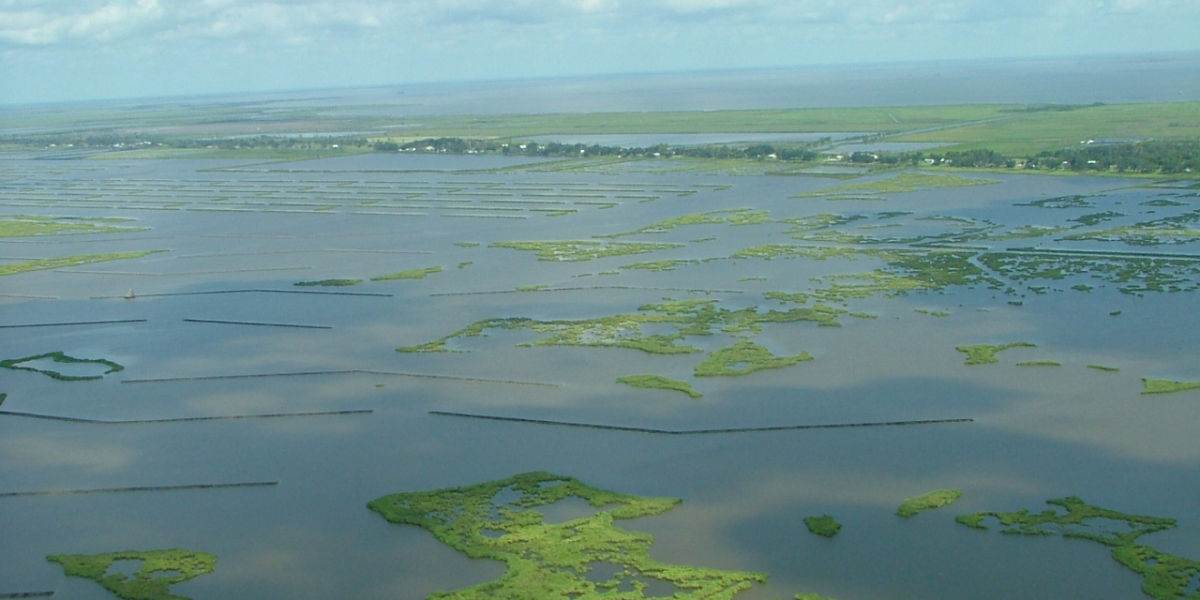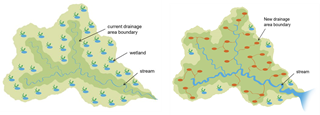
As water moves from headwaters through river systems and ultimately reaches estuaries, wetlands along the way play vital roles in storing and slowly releasing flood waters. In Headwater Areas like the Rocky Mountains and Prairie Pothole Region, wetlands function as sponges, absorbing runoff from snowmelt and rainfall. When wetlands are drained, the drainage area boundary increases, water moves downstream faster and flood peaks increase. DU biologists and engineers work with landowners in headwater areas with voluntary, incentive-based programs to conserve wetlands and reduce downstream flooding.

Diagram comparing a natural watershed with intact wetlands (left) to altered watershed with drained wetlands (right).
Along River Systems: When floodwaters move into rivers, overbank flooding can and does occur. When floodplain wetlands are in place, floodwaters enter and spread out across wetlands slowing the flow and reducing downstream peaks. Sediment falls out when turbid waters slow and water quality is improved. Floodwaters are stored in floodplain wetlands until river levels fall and then are slowly released back into the river system. This rise and fall of river systems works well when natural wetlands are in place. When wetlands are removed and replaced with roads, buildings and other infrastructure, catastrophic damage occurs when flood waters breach levees and spill into communities. Ducks Unlimited works with landowners and communities along river systems such as the Mississippi River to restore and protect wetlands as natural infrastructure to reduce the impacts of riverine flooding.
In Coastal Areas: When floodwaters reach coastal areas, they play a vital role in building deltaic wetlands as nutrient-rich sediments are deposited to counter tidal and tropical storm erosional processes. DU works with state and federal agencies along with corporations and foundations near the mouth of the Mississippi River to establish crevasse splays by breaching levees. Once levees are breached, sediment laden river water spreads onto the floodplain adding elevation and allowing coastal wetlands to regenerate.
Elsewhere along the Pacific, Atlantic and Gulf coasts, Ducks Unlimited biologists and engineers work to restore wetlands to protect communities from flooding and create more resilient coastlines. Along the Gulf Coast, we use marsh terraces and breakwaters to slow wave action and allow wetland vegetation to become established. These wetlands provide habitat for waterfowl, fin fish and shellfish while protecting more inland sites. On Atlantic and Pacific coastal sites, DU is working with agency and corporate partners to restore tidal flow to areas with significant subsidence. As marshes are renourished by sediment, wetland vegetation recovers and storm surge mitigation improves.
Please contact us to find out how we can work together to conserve wetlands to reduce flooding and help out coastlines be more resilient.
Ducks Unlimited uses cookies to enhance your browsing experience, optimize site functionality, analyze traffic, and deliver personalized advertising through third parties. By continuing to use this site, you agree to our use of cookies. View Privacy Policy